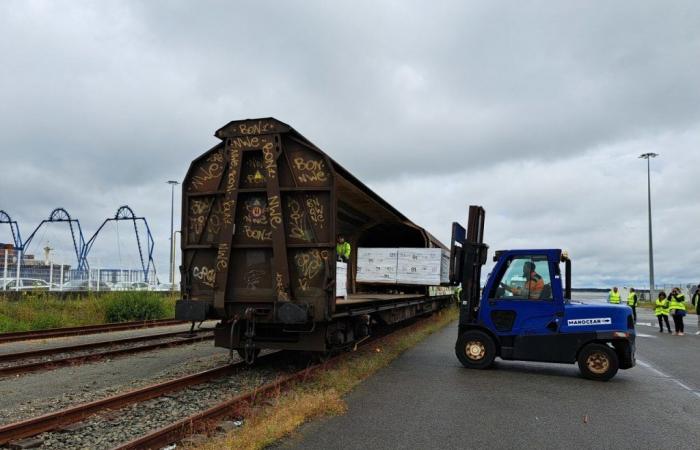Par
Melissa Dupin
Published on
June 25, 2024 at 2:46 p.m.
See my news
Follow L’Écho de la Presqu’île
A Wednesday afternoon on the quays of port of Montoir-de-Bretagne (Loire-Atlantique), a forklift goes back and forth between a platform where packages of granite are piled up and a wagon. Once loaded, the train will reach Nantes then the east of France. Since December 25, 2023, a wagon leaves the port every week filled with granite coming from Portugal. Travel time: between two and five days.
These pallets could have traveled 1,700 km by truck between Galicia and the Part-Dieu station site in Lyon. The 3,000 tonnes of granite will ultimately only travel 40 km by road.
Rail makes it possible to divide CO2 emissions by 5
The De Filippis company, specialized in urban development work, chose another solution, one that combines sea and railthe Vigo-Montoir maritime line and rail freight.
The City of Lyon wanted a low-carbon approach for the development of the Part-Dieu station square. The granite travels approximately 30 km, between the quarry and the port of Vigo, on a rolling platform. He joined the port of Montoir aboard one of the Suardiaz ro-ro ships. It is then transferred to a wagon and then reaches the Saint-Priest station, where it still has 10 km of road to travel to Part-Dieu.
Nearly €10 million invested
This is what we call maritime-railway modal shift. “It’s a great success,” says Jérôme Guizou, development director at the Port of Nantes-Saint-Nazaire. Abandoned in the 1980s in favor of road transport, rail transport could return to the forefront. The port would like to develop this means of transport, which represents less than 10% of traffic.
Over the last 10 years, it has invested 9.5 million euros to rehabilitate existing infrastructure. Today he operates 32 km of tracks mainly for grain transport.
We have a lot of room for improvement.
50 tonnes per wagon
Trains allow you to divide CO2 emissions by 5, a saving of 335 tonnes of CO2, or more than 3,000 Lyon-Paris journeys by road. “A wagon can transport 50 tonnes of granite, or two trucks less on the roads,” remarks Jérôme Guizou.
For the moment, the train leaves Lyon empty. But the port hopes to find customers to transport goods to Montoir.
Decarbonize freight transport
Until recently, road transport was too competitive, but for the director of development of the Grand Port, this is no longer necessarily true today.
With the rise in the cost of fuel, taxes and increasingly stringent regulatory constraints, rail becomes interesting above 400 km.
All that remains is to convince customers to take the plunge. “Our role is to support them by allowing them to decarbonize freight transport as much as possible. We have a shooting window that opens, it’s up to us to be ready,” explains Jérôme Guizou.
With in particular the future regular Neoliner shipping line which will connect Montoir to the east of the United States from 2025.
Follow all the news from your favorite cities and media by subscribing to Mon -.






